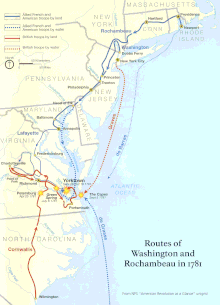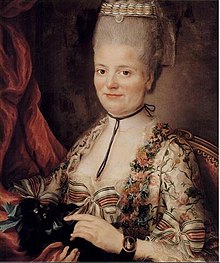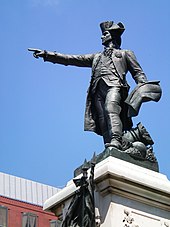| Jean-Baptiste Donatien de Vimeur de Rochambeau | |
|---|---|
 Portrait by Charles Wilson Peale, 1782 Portrait by Charles Wilson Peale, 1782 | |
| Born | (1725-07-01)1 July 1725 Vendôme, Orléanais, France |
| Died | 30 May 1807(1807-05-30) (aged 81) Thoré, Loir-et-Cher, France |
| Allegiance | France |
| Service | French Royal Army |
| Years of service | 1742–1792 |
| Battles / wars | |
| Awards | Society of the Cincinnati |
| Signature | |
Jean-Baptiste Donatien de Vimeur, comte de Rochambeau (1 July 1725 – 10 May 1807) was a French Royal Army officer and nobleman who played a critical role in the Franco-American victory at siege of Yorktown in 1781 during the American Revolutionary War. He was commander-in-chief of the Expédition Particulière, the French expeditionary force sent to help the Americans fight against British forces.
Military life
Jean-Baptiste Donatien de Vimeur was born in Vendôme, in the province of Orléanais, and he was educated at the Jesuit college in Blois. After the death of his elder brother, he entered a cavalry regiment and served in Bohemia, Bavaria, and on the Rhine during the War of the Austrian Succession. By 1747, he had attained the rank of colonel. He took part in the Siege of Maastricht and became governor of Vendôme in 1749. He distinguished himself in the Battle of Minorca on the outbreak of the Seven Years' War and was promoted to brigadier general of infantry. In 1758, he fought in Germany, notably in the Battle of Krefeld and the Battle of Clostercamp, receiving several wounds at Clostercamp.
American Revolution
Main article: Franco-American alliance

In 1780, Rochambeau was appointed commander of land forces as part of the project code-named Expédition Particulière. He was given the rank of lieutenant general in command of 7,000 French troops and sent to join the Continental Army under George Washington during the American Revolutionary War. Axel von Fersen the Younger served as his aide-de-camp and interpreter. The small size of the force at his disposal made him initially reluctant to lead the expedition.


He landed at Newport, Rhode Island on 10 July but was held there inactive for a year due to his reluctance to abandon the French fleet blockaded by the British in Narragansett Bay. The college in the Colony of Rhode Island and Providence Plantations (now Brown University) served as an encampment site for some of Rochambeau's troops. The college edifice was converted into a military hospital, now known as University Hall. In July 1781, the force left Rhode Island and marched across Connecticut to join Washington on the Hudson River in Mount Kisco, New York. The Odell farm served as Rochambeau's headquarters from 6 July to 18 August 1781.
Washington and Rochambeau then marched their combined forces to the Siege of Yorktown and the Battle of the Chesapeake. On 22 September, they combined with the Marquis de Lafayette's troops and forced Lord Cornwallis to surrender on 19 October. The Congress of the Confederation presented Rochambeau with two cannons taken from the British in recognition of his service. He returned them to Vendôme, and they were requisitioned in 1792.
Return to France
Upon his return to France, Rochambeau was honored by King Louis XVI and was made governor of the province of Picardy. He supported the French Revolution of 1789, and on 28 December 1791, he and Nicolas Luckner became the last two generals created Marshal of France by Louis XVI.
When the French Revolutionary Wars broke out, he commanded the Armée du Nord for a time in 1792 but resigned after several reversals to the Austrians. He was arrested during the Reign of Terror in 1793–1794 and imprisoned in the Conciergerie. He narrowly avoided the guillotine, with his execution being scheduled mere days away when the Thermidorian Reaction occurred, ending the Reign of Terror.
Later life and death
After his imprisonment and subsequent release, Rochambeau was pensioned after meeting Napoleon in 1801 and later received the Légion d'honneur in 1804 after Napoleon's ascension to emperor. Rochambeau died in 1807 at Thoré-la-Rochette during the First French Empire.
His son Donatien was also a French general.
Legacy
Honors

President Theodore Roosevelt unveiled a statue of Rochambeau by Ferdinand Hamar as a gift from France to the United States on 24 May 1902, standing in Lafayette Square, Washington, D.C. The ceremony was made the occasion of a great demonstration of friendship between the two nations. France was represented by ambassador Jules Cambon, Admiral Fournier, General Henri Brugère, and a detachment of sailors and marines from the battleship Gaulois. Representatives of the Lafayette and Rochambeau families also attended. A Rochambeau fête was held simultaneously in Paris. In 1934, A. Kingsley Macomber donated a statue of General Rochambeau to Newport, Rhode Island. The sculpture is a replica of a statue in Paris.
The French Navy gave his name to the ironclad frigate Rochambeau. USS Rochambeau was a transport ship that saw service in the United States Navy during World War II. President Obama signed the Omnibus Public Land Management Act on 30 March 2009 with a provision to designate the Washington-Rochambeau Revolutionary Route as a National Historic Trail. A bridge was named for Rochambeau in the complex of bridges known as the 14th Street Bridge (Potomac River) connecting Washington, D.C., with Virginia. A mansion on the campus of Brown University is named Rochambeau House and houses the French Department.
Memoirs

Rochambeau's Mémoires militaires, historiques et politiques, de Rochambeau was published by Jean-Charles-Julien Luce de Lancival in 1809. Part of the first volume was translated into English and published in 1838 under the title Memoirs of the Marshal Count de R. relative to the War of Independence in the United States. His correspondence during the American campaign was published in 1892 in H. Doniol's History of French Participation in the Establishment of the United States.
Monuments

- There is a statue of Rochambeau in Newport, Rhode Island, and another in Washington, D.C., on Pennsylvania Avenue across from the White House in Lafayette Park that was sculpted by Fernand Hamar and cast by the Pal d'Osne foundry in France and dedicated 24 May 1904
- There is a Rochambeau monument at French Hill in Marion, Connecticut, close to the Asa Barnes Tavern, the eighth campsite of his troops through Connecticut in 1781.
Motto and coat of arms
| Coat of arms | Motto |

|
|
Notes
- ^
 One or more of the preceding sentences incorporates text from a publication now in the public domain: Chisholm, Hugh, ed. (1911). "Rochambeau, Jean Baptiste Donatien de Vimeur". Encyclopædia Britannica. Vol. 23 (11th ed.). Cambridge University Press. pp. 425–26.
One or more of the preceding sentences incorporates text from a publication now in the public domain: Chisholm, Hugh, ed. (1911). "Rochambeau, Jean Baptiste Donatien de Vimeur". Encyclopædia Britannica. Vol. 23 (11th ed.). Cambridge University Press. pp. 425–26.
- Kennett, Lee (1977). The French Forces in America, 1780–1783. Greenwood Press, Inc. p. 10
- Herbermann, Charles, ed. (1913). "Jean-Baptiste-Donatien de Vimeur, Count de Rochambeau" . Catholic Encyclopedia. New York: Robert Appleton Company.
- "05-137 (March to Yorktown)".
- Lenore M. Rennenkampf (February 1973). "National Register of Historic Places Registration: Odell House". New York State Office of Parks, Recreation and Historic Preservation. Archived from the original on 18 October 2012. Retrieved 24 December 2010.
- ^ "General Jean Baptiste Donatien de Vimeur, comte de Rochambeau". National Park Service. National Park Service. Retrieved 21 March 2024.
- "Rochambeau, (sculpture)". Smithsonian.
- de Rochambeau, Count, and M. W. E. Wright (1917). "What France Did for America: Memoirs of Rochambeau". The North American Review. 205 (738): 788–802. JSTOR 25151043?seq=1.
{{cite journal}}: CS1 maint: multiple names: authors list (link) - Doniol, H. Histoire de la participation de la France en l'établissement des Etats Unis d'Amérique, Vol. V. Paris: 1892
- Johannes Baptist Rietstap, Armorial général : contenant la description des armoiries des familles nobles et patriciennes de l'Europe : précédé d'un dictionnaire des termes du blason, G.B. van Goor, 1861, 1171 p
References
- "Jean Baptiste Donatien De Vimeur Rochambeau." in Dictionary of American Biography (1936). online
- Kennett, Lee. The French Forces in America, 1780–1783 (Greenwood, 1977),
- Nager, Cody E. "The Fading Mirage Of Revolution: The French Expeditionary Force's Disillusionment With America, 1780–1782." The Historian 81#3 (2019), pp. 426+. online
- Whitridge, Arnold. "Rochambeau And The American Revolution" History Today (May 1962), Vol. 12 Iss. 5, pp. 312–320.
- Tugdual de Langlais, L'armateur préféré de Beaumarchais Jean Peltier Dudoyer, de Nantes à l'Isle de France, Éd. Coiffard, 2015, 340 p. (ISBN 9782919339280).
- Jean-Baptiste-Donatien de Vimeur, comte de Rochambeau, Memoirs of the Marshal Count de Rochambeau, Relative to the War of Independence of the United States, ed. and trans, by M.W.E. Wright (New York: The New York Times and Arno Press, 1971),
- Arnaud Blondet, Préface Iris de Rode Jeux de guerre, l'histoire de l'armée de Rochambeau au secours des États-Unis 1780–1781 Tome I, Éditions Jean-Jacques Wuillaume – Trace ta vie, collection Histoire et Patrimoine, 2024, 384 pages. ISBN 9791095373513
- conférence des associations Amis de Rochambeau et France-Etats-unis41 :https://www.youtube.com/watch?v=V958r618JWk&t=6s
External links
Library resources aboutRochambeau
- Society of the Cincinnati
- American Revolution Institute
- France and the American Revolution at the John Carter Brown Library
- Jean-Baptiste-Donatien Count de Rochambeau at Find a Grave